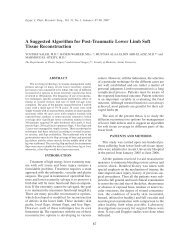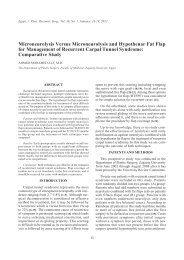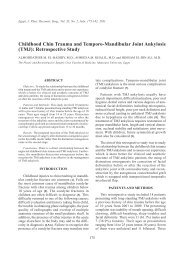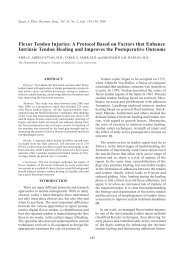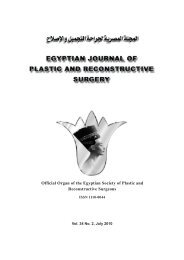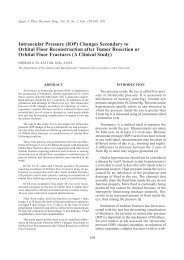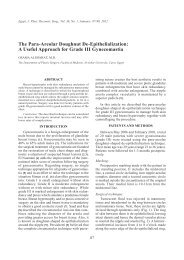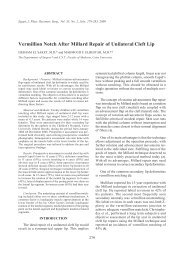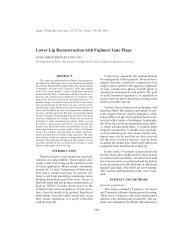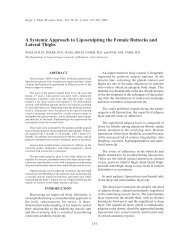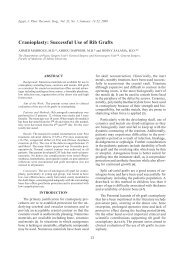The Lateral Supramalleolar Flap for Reconstruction of the ... - ESPRS
The Lateral Supramalleolar Flap for Reconstruction of the ... - ESPRS
The Lateral Supramalleolar Flap for Reconstruction of the ... - ESPRS
Create successful ePaper yourself
Turn your PDF publications into a flip-book with our unique Google optimized e-Paper software.
Egypt, J. Plast. Reconstr. Surg., Vol. 34, No. 2, July: 167-171, 2010<br />
<strong>The</strong> <strong>Lateral</strong> <strong>Supramalleolar</strong> <strong>Flap</strong> <strong>for</strong> <strong>Reconstruction</strong> <strong>of</strong><br />
<strong>the</strong> Distal Leg and Foot<br />
MAGDY ABD AL MOKTADER, M.D.; MONA HASSAN, M.D.; WAEL AYAD, M.D.;<br />
TAREK ELBANOBY, M.D. and ESSAM TAMAN, M.D.<br />
<strong>The</strong> Department <strong>of</strong> Plastic and Reconstructive Surgery, Faculty <strong>of</strong> Medicine, Al-Azhar University.<br />
ABSTRACT<br />
We describe our experience and evaluate <strong>the</strong> reliability<br />
<strong>of</strong>, <strong>the</strong> lateral supramalleolar flap that was used in 16 patients<br />
<strong>for</strong> reconstruction <strong>of</strong> <strong>the</strong> distal leg and foot. <strong>The</strong>re were 10<br />
men and 6 women, age range 2-60 years. <strong>The</strong> causes <strong>of</strong> <strong>the</strong><br />
skin defects included trauma, deep burn and diabetic ulcer.<br />
Sites <strong>of</strong> <strong>the</strong> defects were <strong>the</strong> lower leg, over <strong>the</strong> malleoli and<br />
in front <strong>of</strong> <strong>the</strong> ankle. Fourteen flaps survived and provided<br />
satisfactory coverage <strong>of</strong> <strong>the</strong> defect. Two flaps showed partial<br />
necrosis and were treated conservatively. We think that <strong>the</strong><br />
lateral supra-malleolar flaps a good way to reconstruct s<strong>of</strong>t<br />
tissue defects <strong>of</strong> <strong>the</strong> lower extremity. It has a large skin paddle<br />
and a wide rotation arc.<br />
INTRODUCTION<br />
<strong>Reconstruction</strong> <strong>of</strong> s<strong>of</strong>t tissue defects <strong>of</strong> <strong>the</strong><br />
lower extremity is a common and challenging<br />
problem. Because <strong>of</strong> <strong>the</strong> limited availability <strong>of</strong><br />
local tissue, particularly in <strong>the</strong> lower leg and foot,<br />
<strong>the</strong> use <strong>of</strong> distant flaps <strong>for</strong> covering those defects<br />
<strong>of</strong>ten looks necessary. Cross leg flaps have been<br />
used in <strong>the</strong> past, but have few indication nowadays.<br />
Free tissue transfer may <strong>of</strong>fer <strong>the</strong> best surgical<br />
option in most cases, use <strong>of</strong> free flaps, however,<br />
is always associated with risk at <strong>the</strong> anastomosis.<br />
As well as <strong>the</strong> free transfer techniques tack long<br />
time. Axial pedicle flaps harvested from <strong>the</strong> leg<br />
can <strong>of</strong>ten provide good and safe reconstructive<br />
solutions with relatively simpler techniques [1].<br />
<strong>The</strong> lateral supramalleolar flap is one <strong>of</strong> <strong>the</strong><br />
series <strong>of</strong> flaps that has been described in <strong>the</strong> last<br />
decades and are based on <strong>the</strong> secondary arteries<br />
<strong>of</strong> <strong>the</strong> limb. It is a fasciocutaneous flap that is<br />
raised on <strong>the</strong> lateral aspect <strong>of</strong> <strong>the</strong> lower leg and it<br />
is usually used as a distally-based pedicle flap <strong>for</strong><br />
covering defects on <strong>the</strong> lower third <strong>of</strong> <strong>the</strong> leg and<br />
<strong>the</strong> foot [2].<br />
167<br />
Surgical anatomy:<br />
<strong>The</strong> lateral supramalleolar flap is a fasciocutaneous<br />
flap raised on <strong>the</strong> distal per<strong>for</strong>ating branch<br />
<strong>of</strong> <strong>the</strong> peroneal artery as its vascular pedicle. Masquelet<br />
et al., showed that <strong>the</strong> per<strong>for</strong>ating branch<br />
<strong>of</strong> <strong>the</strong> posterior peroneal artery consistently emerges<br />
from a groove between <strong>the</strong> tibia and <strong>the</strong> fibula,<br />
just proximal to <strong>the</strong> distal tibi<strong>of</strong>ibular ligament<br />
and can be found 5cm above <strong>the</strong> lateral malleolus.<br />
It divides into a superficial (ascending) cutaneous<br />
and a deep descending branch shortly after per<strong>for</strong>ating<br />
<strong>the</strong> interosseous membrane. <strong>The</strong> superficial<br />
cutaneous branch supplies a skin territory approximately<br />
12.0-18.0cm in length and 9.0cm in width,<br />
corresponding to an area on <strong>the</strong> lower half <strong>of</strong> <strong>the</strong><br />
leg from <strong>the</strong> tibial crest to <strong>the</strong> posterior margin <strong>of</strong><br />
<strong>the</strong> fibula [3].<br />
MATERIAL AND METHODS<br />
Sixteen patients with various defects <strong>of</strong> <strong>the</strong><br />
distal leg and foot caused by different etiological<br />
factors were managed by lateral supramalleolar<br />
flap. A total <strong>of</strong> 16 patients admitted during <strong>the</strong><br />
period <strong>of</strong> September’ 2007 to May’ 2009 with<br />
lower limb defect/wound with exposed bone (tibia/<br />
fibula) and/or in front <strong>of</strong> <strong>the</strong> ankle joint. <strong>The</strong> study<br />
was conducted in <strong>the</strong> department <strong>of</strong> Plastic Surgery,<br />
in Al-Azhar University Hospital.<br />
<strong>The</strong> patients were submitted to a preoperative<br />
mapping study with echodoppler to identify <strong>the</strong><br />
closest per<strong>for</strong>ating vessels to <strong>the</strong> injury margin.<br />
Once per<strong>for</strong>ating vessels topography was identified,<br />
<strong>the</strong>se were outlined with a dermographic pen. Based<br />
on this previous mapping, patches were designed<br />
on donor areas considering <strong>the</strong> longitudinal axis
168 Vol. 34, No. 2 / <strong>The</strong> <strong>Lateral</strong> <strong>Supramalleolar</strong> <strong>Flap</strong> <strong>for</strong> <strong>Reconstruction</strong><br />
<strong>of</strong> <strong>the</strong> main vessel, as well as <strong>the</strong> length and width<br />
required <strong>for</strong> covering <strong>the</strong> skin defect without tension.<br />
Surgical technique:<br />
<strong>The</strong> patient is placed supine with a roll or a<br />
pillow placed under <strong>the</strong> ipsilateral hip. Assessment<br />
<strong>of</strong> <strong>the</strong> defect is carried out and <strong>the</strong> size <strong>of</strong> <strong>the</strong> flap<br />
marked within <strong>the</strong> vascular territory. A hand-held<br />
Doppler probe can be used to locate <strong>the</strong> per<strong>for</strong>ating<br />
branch, and its position is marked. A tourniquet is<br />
used during <strong>the</strong> dissection. <strong>The</strong> ulcer is excised<br />
and <strong>the</strong> defect thoroughly irrigated. <strong>The</strong> margins<br />
<strong>of</strong> <strong>the</strong> flap are <strong>the</strong>n incised down to <strong>the</strong> deep fascia.<br />
<strong>The</strong> deep fascia is incised and <strong>the</strong> flap raised<br />
proximally to distally in <strong>the</strong> sub-fascial plane to<br />
locate <strong>the</strong> per<strong>for</strong>ator. Once <strong>the</strong> per<strong>for</strong>ator is located<br />
and preserved, <strong>the</strong> remainder <strong>of</strong> <strong>the</strong> flap is raised<br />
(Fig. 2). <strong>The</strong> flap is <strong>the</strong>n rotated into <strong>the</strong> defect<br />
based on its vascular pedicle. A drain is placed<br />
under <strong>the</strong> flap and <strong>the</strong> flap can <strong>the</strong>n be sutured in<br />
place. <strong>The</strong> donor can be closed directly if <strong>the</strong> width<br />
<strong>of</strong> <strong>the</strong> flap less than 3cm. O<strong>the</strong>rwise, A split-<br />
(A)<br />
(C)<br />
thickness skin graft is harvested and secured onto<br />
<strong>the</strong> secondary defect (Figs. 1,2,3). <strong>The</strong> wounds are<br />
dressed [4].<br />
RESULTS<br />
<strong>The</strong> lateral supramalleolar flaps were per<strong>for</strong>med<br />
in 16 cases from 2007 to 2009. Of <strong>the</strong>se 10 were<br />
males and 6 were females. Ages ranged from 2<br />
years to 60 years with an average <strong>of</strong> 38. <strong>The</strong> flaps<br />
were successful in 14 cases. <strong>The</strong> take <strong>of</strong> <strong>the</strong> skin<br />
graft on <strong>the</strong> donor defect was good in all cases.<br />
Complications such as marginal necrosis <strong>of</strong> <strong>the</strong><br />
flap were encountered in two cases and were treated<br />
conservatively. Active movement was encouraged<br />
after 1 month.<br />
<strong>The</strong> follow-up period ranged from 1 to 3 years.<br />
In general, <strong>the</strong> texture, thickness and color <strong>of</strong> <strong>the</strong><br />
flaps matched <strong>the</strong> surrounding, and patients were<br />
satisfied with <strong>the</strong> results. <strong>The</strong> thickness <strong>of</strong> <strong>the</strong> flap<br />
was suitable to cover <strong>the</strong> dorsum <strong>of</strong> <strong>the</strong> foot, medial<br />
and lateral malleoli (Figs. 1,2,3).<br />
Fig. (1): (A) Post-traumatic s<strong>of</strong>t tissue defect over <strong>the</strong> distal part <strong>of</strong> tibia that is exposing <strong>the</strong> underlying bone in 36-years old<br />
woman. (B) Design <strong>of</strong> <strong>the</strong> flap. (C) Elevation <strong>of</strong> <strong>the</strong> flap. (D) Final result 3 months later.<br />
(B)<br />
(D)
Egypt, J. Plast. Reconstr. Surg., July 2010 169<br />
(A)<br />
(C)<br />
Fig. (2): (A) Post-traumatic s<strong>of</strong>t tissue defect over <strong>the</strong> medial malleolus that is exposing<br />
<strong>the</strong> underlying bone in 30-years old man. (B) Design <strong>of</strong> <strong>the</strong> flap. (C) Elevation <strong>of</strong><br />
<strong>the</strong> flap showing per<strong>for</strong>ating branch <strong>of</strong> peroneal artery. (D) Final resul at 7 months.<br />
(A) (B) (C) (D)<br />
Fig. (3): (A) Post-burn contracture in front <strong>of</strong> <strong>the</strong> right ankle in 35-years old woman with<br />
dorsiflection <strong>of</strong> foot. (B) Design <strong>of</strong> <strong>the</strong> flap 5x12cm. (C) Elevation <strong>of</strong> <strong>the</strong> distally<br />
based flap. (D) Final result after 1 year.<br />
(B)<br />
(D)
170 Vol. 34, No. 2 / <strong>The</strong> <strong>Lateral</strong> <strong>Supramalleolar</strong> <strong>Flap</strong> <strong>for</strong> <strong>Reconstruction</strong><br />
Table (1): Patients data.<br />
Patient<br />
1<br />
2<br />
3<br />
4<br />
5<br />
6<br />
7<br />
8<br />
9<br />
10<br />
11<br />
12<br />
13<br />
14<br />
15<br />
16<br />
Age<br />
20<br />
43<br />
2<br />
33<br />
38<br />
37<br />
43<br />
57<br />
8<br />
59<br />
60<br />
60<br />
30<br />
60<br />
18<br />
36<br />
DISCUSSION<br />
Gender<br />
M<br />
M<br />
M<br />
M<br />
M<br />
M<br />
M<br />
M<br />
M<br />
M<br />
F<br />
F<br />
F<br />
F<br />
F<br />
F<br />
Etiology<br />
Traumatic<br />
Traumatic<br />
Deep burn<br />
Traumatic<br />
Traumatic<br />
Traumatic<br />
Deep burn<br />
Diabetes<br />
Traumatic<br />
Diabetes<br />
Diabetes<br />
Pressure<br />
Traumatic<br />
Pressure<br />
Deep burn<br />
Traumatic<br />
Deep skin injuries <strong>of</strong> <strong>the</strong> leg's distal third will<br />
certainly leave tendons, vasculonervous bundles,<br />
and bones exposed, which must be protected with<br />
good quality and good vascularization tissues so<br />
as to prevent deep infections and deterioration <strong>of</strong><br />
such structures. Skin grafts are contraindicated in<br />
<strong>the</strong>se circumstances. Muscle flaps, such as soleus<br />
and gastrocnemius, are restricted <strong>for</strong> use to proximal<br />
two thirds <strong>of</strong> <strong>the</strong> leg [5].<br />
At this level, <strong>the</strong> well known alternatives are<br />
<strong>the</strong> islands <strong>of</strong> reverse-flow pedicle flap, microsurgical<br />
flap. <strong>The</strong> disadvantages <strong>of</strong> free flaps, <strong>of</strong><br />
course, are that <strong>the</strong>y require a significant operative<br />
time (4 to 8 hours) and healthy recipient vessels.<br />
In addition, <strong>the</strong>re is <strong>the</strong> donor-site morbidity to<br />
consider and a prolonged hospital stay that usually<br />
requires one night in <strong>the</strong> intensive care unit <strong>for</strong><br />
flap monitoring. <strong>The</strong> advantage <strong>of</strong> free flap reconstruction<br />
is that <strong>the</strong> Achilles tendon is covered with<br />
a healthy layer <strong>of</strong> viable tissue that decreases <strong>the</strong><br />
risk <strong>of</strong> te<strong>the</strong>ring and subsequent ulceration [6].<br />
Local and pedicle flaps are also viable options.<br />
<strong>The</strong> lateral supramalleolar flap can be used <strong>for</strong> a<br />
very distal foot defect coverage involving both<br />
surfaces. Since its description by Masquelet et al.,<br />
supramalleolar neur<strong>of</strong>ascio-utaneous flap has become<br />
an alternative to sural flap, which covers<br />
more distal areas <strong>of</strong> <strong>the</strong> foot even better and also<br />
acts as a substitute <strong>for</strong> free flaps in <strong>the</strong> distal leg,<br />
ankle, and foot s<strong>of</strong>t tissue defects [7].<br />
Defect site<br />
Medial malleolus<br />
<strong>Lateral</strong> malleolus<br />
Dorsum <strong>of</strong> foot<br />
Distal leg<br />
Dorsum <strong>of</strong> foot<br />
<strong>Lateral</strong> malleolus<br />
Front <strong>of</strong> ankle<br />
Distal lig<br />
<strong>Lateral</strong> malleolus<br />
<strong>Lateral</strong> aspect <strong>of</strong> foot<br />
<strong>Lateral</strong> malleolus<br />
<strong>Lateral</strong> malleolus<br />
Distal part <strong>of</strong> tibia<br />
<strong>Lateral</strong> malleolus<br />
Front <strong>of</strong> ankle<br />
Distal leg<br />
Defect Size<br />
4x8<br />
3x4<br />
3x5<br />
3x8<br />
4x8<br />
3x4<br />
5x10<br />
4x10<br />
3x4<br />
3x10<br />
4x4<br />
3x3<br />
3x6<br />
3x4<br />
5x12<br />
3x11<br />
Refinements in <strong>the</strong> technique increased its<br />
reliability and mobility while decreasing donor<br />
side morbidity as a distally based flap with a<br />
compound vascular pedicle and subcutaneous tissue<br />
design. With a pivot point over <strong>the</strong> tarsal bone, our<br />
experience confirmed that a thin, large flap could<br />
reach <strong>the</strong> most distal areas <strong>of</strong> <strong>the</strong> foot, and <strong>the</strong>n<br />
even turn downwards to cover distal plantar surface.<br />
Obvious contour de<strong>for</strong>mity <strong>of</strong> <strong>the</strong> donor site is a<br />
significant [8].<br />
<strong>Flap</strong> delay enhanced survival and extended <strong>the</strong><br />
viable dimensions <strong>of</strong> lateral supramalleolar flap.<br />
Compromised circulation in larger flaps and flaps<br />
with vascular variations can be improved by delaying<br />
flap transfer to <strong>the</strong> recipient site <strong>for</strong> 48 hours<br />
following its elevation [9].<br />
<strong>The</strong> survivability <strong>of</strong> <strong>the</strong>se flaps can be explained<br />
in three ways:<br />
1- Adequate perfusion pressure through <strong>the</strong> incorporated<br />
per<strong>for</strong>ators.<br />
2- <strong>The</strong>se per<strong>for</strong>ators <strong>for</strong>m rich supra and sub fascial<br />
plexus at <strong>the</strong> level <strong>of</strong> deep fascia intercommunicating<br />
with <strong>the</strong> supply <strong>of</strong> adjacent per<strong>for</strong>ators.<br />
3- <strong>The</strong>se fascial plexuses are orientated axially,<br />
thus making <strong>the</strong> flap behave like an axial flap<br />
[10].<br />
Hence, it is not only <strong>the</strong> rich plexus <strong>of</strong> vessels<br />
associated with <strong>the</strong> fascia, but also <strong>the</strong>ir orientation<br />
that is responsible <strong>for</strong> survival <strong>of</strong> flaps <strong>of</strong> 3:1
Egypt, J. Plast. Reconstr. Surg., July 2010 171<br />
length: breadth ratio or more. This is also <strong>the</strong> basis<br />
<strong>of</strong> perfusion <strong>of</strong> island flaps [11].<br />
Conclusion:<br />
<strong>The</strong> simplicity <strong>of</strong> design and elevation plus<br />
<strong>the</strong>ir extensive arc <strong>of</strong> rotation make <strong>the</strong> supramalleolar<br />
flap, reliable in <strong>the</strong> reconstruction <strong>of</strong> difficult<br />
defects <strong>of</strong> <strong>the</strong> lower limb. We have found several<br />
advantages <strong>of</strong> this flap, <strong>the</strong>y include:<br />
1- Safety with no sacrifice <strong>of</strong> major arteries or<br />
nerves at donor site.<br />
2- Technically easy and quick dissection.<br />
3- Reliability, longitudinally oriented axial pattern<br />
flap.<br />
4- Single stage without microsurgery.<br />
REFERENCES<br />
1- Demiri E., Foroglou P., Dionyssiou D., et al.: Our experience<br />
with lateral supramalleolar island flap <strong>for</strong> reconstruction<br />
<strong>of</strong> <strong>the</strong> distal leg and foot:A review <strong>of</strong> 20 cases.<br />
Scand. J. Plast. Reconstr. Hand Surg., 40: 106, 2006.<br />
2- Voche P., Merle M. and Stussi J.D.: <strong>The</strong> lateral supramalleolar<br />
flap: Experience with 41flaps. Ann. Plast. Surg.,<br />
54: 49-54, 2005.<br />
3- Masquelet A.C., Beveridge J., RomanaC. and Gerber C.:<br />
<strong>The</strong> lateral supra-malleolar flap. Plast. Reconstr. Surg.,<br />
81: 74, 1988.<br />
4- Sham E., Choi W.T. and Flood S.J.: <strong>Lateral</strong> supramalleolar<br />
flap in reconstruction <strong>of</strong> pressure ulcers in patients with<br />
spinal cord injury. Anz. J. Surg., 78: 167, 2008.<br />
5- De Rezende M.R., Rabelo N.T.A., Benabou J.E., et al.:<br />
Cvering <strong>the</strong> distal third <strong>of</strong> <strong>the</strong> leg with pedicled per<strong>for</strong>ating<br />
vessels patches. Acta. Ortop. Bras., 16: 223, 2008.<br />
6- Attinger C.E., Ducic I., Hess C.L., et al.: Outcome <strong>of</strong> skin<br />
graft versus flap surgery in <strong>the</strong> salvage <strong>of</strong> <strong>the</strong> exposed<br />
achilles tendon in diabetics versus non diabetics. Plast.<br />
Reconstr. Surg., 17: 2460, 2006.<br />
7- Touam C., Rostoucher P., Bhatia A. and Oberlin: Comparative<br />
study <strong>of</strong> two series <strong>of</strong> distally based fasciocutaneous<br />
flaps <strong>for</strong> coverage <strong>of</strong> <strong>the</strong> lower one-fourth <strong>of</strong> <strong>the</strong> leg, <strong>the</strong><br />
ankle, and <strong>the</strong> foot. Plast. Reconstr. Surg., 107: 383, 2001.<br />
8- Agir H., Sen C. and Onyedi M.: Extended <strong>Lateral</strong> <strong>Supramalleolar</strong><br />
<strong>Flap</strong> <strong>for</strong> Very Distal Foot Coverage: A Case<br />
With Arteriovenous Mal<strong>for</strong>mation. Ankle Surg., 46: 310,<br />
2007.<br />
9- Ahmed S.K. and Hashmi P.M.: Delayed supramalleolar<br />
flap: An innovative technique <strong>for</strong> enhanced viability. J.<br />
Ayub Med. Coll. Abbottabad, 3: 17, 2005.<br />
10- Bhattacharya V., Watts R.K. and Reddy G.R.: Live demonstration<br />
<strong>of</strong> microcirculation in deep fascia and its<br />
implication. Plast. Reconstr. Surg., 115: 458, 2005.<br />
11- Bhattacharya V., Reddy G.R., Goyal S. and Kumar U.:<br />
Skeletonised retrograde distal per<strong>for</strong>ator island fascioutaneous<br />
flaps <strong>for</strong> leg and foot defects. J. Plast. Reconstr.<br />
Aesth. Surg., 60: 892, 2007.





